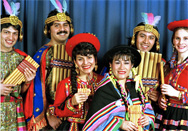
“The world’s indigenous peoples have preserved a vast amount of humanity’s cultural history. Indigenous peoples speak a majority of the world’s languages, and have inherited and passed on a wealth of knowledge, artistic forms and religious and cultural traditions. On this International Day of the World’s Indigenous Peoples, we reaffirm our commitment to their well-being”, said Secretary-General Ban Ki-Moon on 9 August during the observation of the Day.
This year’s observance at UN Headquarters in New York marked the midpoint of the Second International Decade for the World’s Indigenous People and focused on indigenous filmmaking. It was organized by the Secretariat of the UN Permanent Forum on Indigenous Issues in cooperation with the NGO Committee on the International Decade of the World’s Indigenous People. The event featured four short films by indigenous film makers from Sweden, Alaska, Russia and the Caribbean.
The International Day of the World’s Indigenous People was first pronounced by the General Assembly in December 1994, to be celebrated every year during the first International Decade of the World’s Indigenous People (1995 – 2004). In 2004, the Assembly proclaimed a Second International Decade, from 2005 – 2015, with the theme of “A Decade for Action and Dignity”.
A main achievement of the Second Decade was the adoption by the General Assembly in 2007 of the Declaration on the Rights of the Indigenous People. This and the Second International Decade has also provided impetus for some governments, such as Japan, Canada and Australia, to recognize the existence and rights of indigenous people and even offer apologies to them for past injustices. Other recent achievements include the creation of consultative institutions for indigenous people and the formation of their own political parties, like in Russia, Nepal and Ecuador.
Secretary-General Ban Ki-Moon stressed that “the landmark UN Declaration on the Rights of Indigenous Peoples lays out a framework for Governments to use in strengthening relationships with indigenous peoples and protecting their human rights”. Since then, more Governments worked to redress social and economic injustices, through legislation and other means, and indigenous peoples’ issues have become more prominent on the international agenda than ever before, he explained.
However Mr. Ban noted that “indigenous peoples – more than 370 million in the world – still experience racism, poor health and disproportionate poverty. In many societies, their languages, religions and cultural traditions are stigmatized and shunned”. He added that in some countries indigenous peoples are 600 times more likely to contract tuberculosis than the general population. In others, an indigenous child can expect to die 20 years before his or her non-indigenous compatriots.
The need for recognition
Under-Secretary-General and coordinator of the decade Mr. Sha Zukang voiced that “the promotion of films, along with other indigenous art forms, is also encouraged and supported by the Declaration and the Second Decade. “These initiatives not only address the social, political and economic rights of indigenous communities. They also draw attention to the need to protect cultural manifestations – in technological, visual and performing art forms”, he said.
Mr. Sha added that “these signs of progress are promising. But we must recognize that many objectives of the Second Decade are in danger of going unfulfilled. Most countries have yet to recognize their indigenous communities. International financial institutions and development organizations need to meet with indigenous groups more frequently and more formally”. Nevertheless, he noted that in places where indigenous people do have recognition, their level of direct political participation, particularly for women, is very low.
Mr. Sha announced that an upcoming report of the Secretary-General will present more information about progress and gaps toward fulfilling the goals and objectives of the Declaration and the Second International Decade. The report will be launched this year in time for the sixty-fifth session of the General Assembly.
Revitalizing traditions and customs
In a statement read by Assistant-Secretary-General Jomo Kwame Sundaram for the Chair of the Permanent Forum on Indigenous Issues Carlos Mamari Condori indicates that there are several articles in the UN Declaration on the rights of indigenous peoples that confirm their right to practice and revitalize their cultural traditions and customs. “Films and especially films written, produced and directed by indigenous peoples are perhaps the most expressive medium for communicating messages about who indigenous peoples were, who indigenous peoples are and who indigenous peoples are striving to become”, he said.
Mr. Mamari highlighted the greater demand for indigenous stories from international audiences and explained that “the motivation behind the involvement of indigenous film makers throughout the world in filmmaking, video production and television transmission can be seen as basic issues of self determination and cultural maintenance” and the right to revitalize their traditions and customs.
“Indigenous filmmakers need a lot of encouragement and support… Filmmaking is a very technical process and therefore it is crucial to cultivate indigenous peoples’ talents in areas of development and production around the world,” said the Chair of the Permanent Forum on Indigenous Issues. He called on governments, intergovernmental organizations, the industry and other relevant actors to strongly support indigenous filmmakers around the world.
For more information: http://www.un.org/esa/socdev/unpfii/index.html
